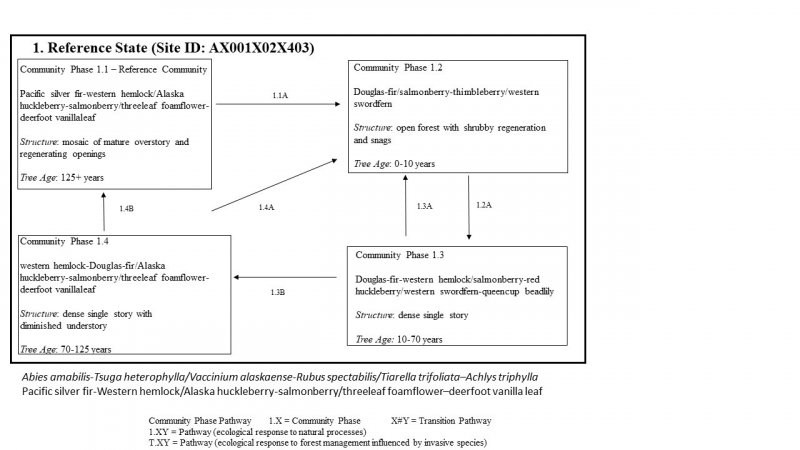
Natural Resources
Conservation Service
Ecological site AX001X02X403
Frigid Udic Moist Forest
Last updated: 1/23/2025
Accessed: 12/18/2025
General information
Provisional. A provisional ecological site description has undergone quality control and quality assurance review. It contains a working state and transition model and enough information to identify the ecological site.
MLRA notes
Major Land Resource Area (MLRA): 001X–Northern Pacific Coast Range, Foothills, and Valleys
This long and narrow resource area stretches along the Pacific Border Province of the Pacific Mountain System in Oregon and Washington. The area is bounded by the Olympic Mountains on the north and the Klamath Mountains on the south. Most of the area consists of hills and low mountains with gentle to steep slopes. The parent materials are composed primarily of young Tertiary sedimentary rocks with some minor volcanic rocks. Glacial till and outwash deposits are found in the northern half of the area within Washington. In the far southern portion of the area, near the Klamath Mountains, the sedimentary rocks are older and some have been metamorphosed. The average annual precipitation ranges from 60 to 200 inches, increasing with elevation.
The dominant soil orders in this MLRA are Andisols, Inceptisols, and Ultisols. Soil depth ranges from shallow to very deep. While most soils in the area are well drained and occur on foothills, mountain slopes and ridges, floodplain and depressional soils can range from well drained to very poorly drained. Soil textures are typically medial, loamy, or clayey. The dominant soils in the area have a mesic or frigid soil temperature regime and a udic soil moisture regime; however, soils with an aquic soil moisture regime or cryic soil temperature regime do occur.
LRU notes
The North Pacific Coast Range land resource unit (LRU 2) of MLRA 1 is located in the northwestern corner on the Olympic Peninsula and within the Olympic National Forest in Washington State. LRU 2 is bounded on the west by MLRA 4a Sitka Spruce Belt and MLRA 2 Willamette and Puget Sound Valleys to the east. LRU 2 encircles the Olympic National Park (LRU 1). Several major rivers have headwaters in this LRU or carved valleys through the landscape depositing more recent alluvium. These include the Duckabush, Elwha, Queets, Quinault, Skokomish, Sol Duc, and Wynoochee Rivers.
Ecological site concept
This ecological site is found on the western Coast Range on the Olympic Peninsula in Washington state. A temperate climate supports a variety of flora and fauna. Elevations are typically between 1,850 and 2,850 feet.
The most common overstory species are Pacific silver fir (Abies amabilis), western hemlock (Tsuga heterophylla), western redcedar (Thuja plicata), and Douglas-fir (Pseudotsuga menziesii). The understory is floristically diverse as a result of more openings in the canopy cover. Common understory species may include Alaska huckleberry (Vaccinium alaskaense), red huckleberry (Vaccinium parvifolium), salmonberry (Rubus spectabilis), threeleaf foamflower (Tiarella trifoliata), deerfoot vanillaleaf (Achlys triphylla), queencup beadlily (Clintonia uniflora), deer fern (Blechnum spicant), common ladyfern (Athyrium filix-femina), and western oakfern (Gymnocarpium dryopteris).
The most common natural disturbance is windthrow of overstory trees, which results in patchy, small pockets of open areas. This in turn creates more canopy openings which allow more sunlight to reach the forest floor, leading to a shrubby understory. Frequent tip-ups also cause these sites to have a hummocky surface with an abundance of down woody debris.
In addition, western hemlock and Pacific silver fir are highly susceptible to rot diseases from fungi such as; Armillaria ostoyae, Heterobasidion annosum, Phellinus weirii, and Echinodontium tinctorium which may exacerbate the extent and area of disturbance. Following root disease, Pacific silver fir is highly susceptible to fir engravers. The resulting openings in the canopy allow sunlight to reach the forest floor, benefiting the understory. Disturbance by fire is infrequent as a result of the high humidity, high elevation, and precipitation within the Pacific silver fir and western hemlock zones. The site has a fire interval of 500 years and may experience stand replacing catastrophic wildfires (US Department of Agriculture, 2012).
Associated sites
| AX001X02X402 |
Frigid Udic Forest Frigid Udic Forest is typically located on steeper slopes within the same elevation range. They are well drained soils and sites lack threeleaf foamflower (Tiarella trifoliata) and common ladyfern (Athyrium filix-femina). |
|---|
Table 1. Dominant plant species
| Tree |
(1) Abies amabilis |
|---|---|
| Shrub |
(1) Vaccinium alaskaense |
| Herbaceous |
(1) Tiarella trifoliata |
Legacy ID
F001XB403WA
Click on box and path labels to scroll to the respective text.
